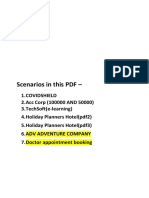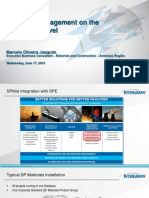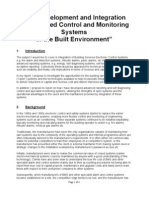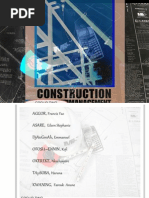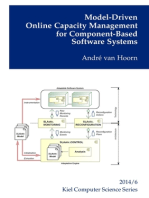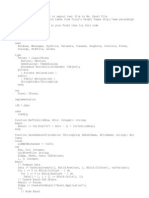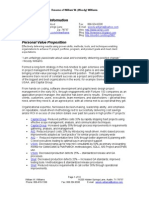0 ratings0% found this document useful (0 votes)
183 viewsSpider Project Presentation
Spider Project Presentation
Uploaded by
Sathish ElangovanSpider Project is a professional project management software package launched in 1992. It is used widely in Russia and other countries for large projects across many industries. Some key advantages include its ability to handle unlimited numbers of project elements, simulate real processes through work volumes and resource productivity, apply corporate norms, and model complex resource assignments. It also offers unique features for optimizing resource-constrained schedules and simulating risks and conditional project networks.
Copyright:
© All Rights Reserved
Available Formats
Download as PDF, TXT or read online from Scribd
Spider Project Presentation
Spider Project Presentation
Uploaded by
Sathish Elangovan0 ratings0% found this document useful (0 votes)
183 views42 pagesSpider Project is a professional project management software package launched in 1992. It is used widely in Russia and other countries for large projects across many industries. Some key advantages include its ability to handle unlimited numbers of project elements, simulate real processes through work volumes and resource productivity, apply corporate norms, and model complex resource assignments. It also offers unique features for optimizing resource-constrained schedules and simulating risks and conditional project networks.
Original Description:
Spider Project
Copyright
© © All Rights Reserved
Available Formats
PDF, TXT or read online from Scribd
Share this document
Did you find this document useful?
Is this content inappropriate?
Spider Project is a professional project management software package launched in 1992. It is used widely in Russia and other countries for large projects across many industries. Some key advantages include its ability to handle unlimited numbers of project elements, simulate real processes through work volumes and resource productivity, apply corporate norms, and model complex resource assignments. It also offers unique features for optimizing resource-constrained schedules and simulating risks and conditional project networks.
Copyright:
© All Rights Reserved
Available Formats
Download as PDF, TXT or read online from Scribd
Download as pdf or txt
0 ratings0% found this document useful (0 votes)
183 views42 pagesSpider Project Presentation
Spider Project Presentation
Uploaded by
Sathish ElangovanSpider Project is a professional project management software package launched in 1992. It is used widely in Russia and other countries for large projects across many industries. Some key advantages include its ability to handle unlimited numbers of project elements, simulate real processes through work volumes and resource productivity, apply corporate norms, and model complex resource assignments. It also offers unique features for optimizing resource-constrained schedules and simulating risks and conditional project networks.
Copyright:
© All Rights Reserved
Available Formats
Download as PDF, TXT or read online from Scribd
Download as pdf or txt
You are on page 1of 42
Spider Project History
• Spider Project - professional project management
software package with unique functionality.
• The first version of the package was launched in 1992
and since then it has a long history of development
and improvements. Now Spider Project is the most
popular professional PM software in Russia and has
customers in 34 other countries on 5 continents.
• It is used in all industries including Aerospace &
Defense, Agriculture, Banking, Construction,
Consulting, Energy, Engineering, Metallurgy, Mining,
Oil & Gas, Retail, Shipbuilding, Software Development,
Telecommunications, Utilities.
Spider Project customers
large scale projects
• Spider Project was and is used in many large scale
projects and programs including:
– Winter Olympic Games 2014 preparation,
– The program of Russian Far East development,
– Development of Bovanenkovo Gas Field,
– Caspian Pipeline Construction,
– Urucu-Manaus Pipeline Construction (Brazil),
– Construction of Moscow 4th Ring Highway,
– Construction of Trans-Siberian highways (Kolyma,
Amur, etc.),
and many others
Spider Project Advantages
• Spider Project wins competition with other PM software
due to wider functionality and better solutions for the
same projects and programs.
• Spider Project users can create project models that
adequately simulate real processes and support any
management approaches (Critical Path, Critical Chain,
Risk Simulation and Management, Project Portfolio
Management, etc.).
• In this presentation we will describe unique features of
Spider Project absent in other PM tools.
• Many management functions and approaches realized in
Spider Project have no analogues to compare with.
Spider Project Power
• Unlimited number of activities, resources,
dependencies, calendars, etc. in project and portfolio
models
• Unlimited number of projects in the project portfolio
• Unlimited number of project, program and portfolio
Work and Resource Breakdown Structures.
• Unlimited number of hierarchical levels in any structure
• Unlimited number of cost components and currencies,
Cost, Resource and Material Centers
• Unlimited number of activity, resource and lag
calendars
For understanding unique Spider Project capabilities it is
necessary to learn what initial information shall be
entered and used in project/program/portfolio models.
Work Volumes and
Resource Productivity
• Usage of work volume (quantity of work to be done)
and resource productivity for activity duration
calculations is critical in construction and
manufacturing management.
• In most packages activity duration is the initial
information for project computer simulation. Spider
Project users can define activity duration or activity
work volume. In the later case SP users shall also
define assigned resource productivity for activity
duration calculations.
•
Corporate Norms
• This feature permits to apply corporate norms in the
process of project planning. Most norms are applied to
work volume unit (like material requirements per
volume unit, unit costs), or to production rates (or
resource productivity).
• Spider Project allows to create and to use corporate
reference-books that contain corporate norms. These
reference-books can be linked with the projects and
used for calculation of activity, resource and
assignment parameters.
Income, Resource and Material
Production and Supplies
• Spider Project simulates not only cost and material
consumption but also financing, production and
supplies.
• Resources can be spent or produced on project
activities. It permits to simulate resource mobilization
processes, resource transfer from one place to another,
etc.
• Spider Project leveling algorithms calculate resource
constrained schedules taking into account not only
resource but also financial and supply limitations.
Multi-resources
• Spider Project users can create multi-resources
(predefined resource crews) and assign them to project
activities.
• At any time in the course of project execution it is
possible to change the set of resources belonging to
some multi-resource and this change will be applied to
all future multi-resource assignments.
• This feature is very useful for the what if analysis and
project resource pool optimization.
Independent Resource Teams
• Spider Project users can assign to activities resource
teams that work together but independently of other
assigned teams.
• Assigning several resource teams simulates the case
when activity can be performed by any of them or as
the result of joint efforts that may take place at
different time periods.
• Independent resource teams assignments allow
simulation of working in several shifts. If several shifts
are assigned to an activity then its work volume (or
duration) will be shared among these teams according
to existing constraints (calendars, availability of
resources, productivity of resources, costs, priorities).
Volume lags
• Spider Project users can assign time or volume lags to
activity dependencies.
• Volume lag defines the volume (or percent) of
preceding activity work amount to be done before the
succeeding event could occur.
Assignment Cost
• Spider Project users can define not only resource,
material and activity costs, but also resource
assignment costs.
• Assignment costs are necessary for control of resource
usage costs when they are paid not for the work hours
but fixed price or for the amount of work done.
Partial Resource Assignments
• Spider Project is the only PM package that correctly
simulates partial resource assignments.
• Unlike other PM packages Spider Project takes into
account both the number of assigned resources and
the planned percentage of their work time that should
be spent on activity execution.
• You can not distinguish between two resources
assigned for 50% of their work time and one assigned
for 100% if to define only total percentage as other
packages do.
•
Variable Resource Workloads
• Spider Project users can define minimum and
maximum number and workload of assigned
resources and let the package to adjust resource
assignments in search for the best schedule.
• The number and workloads of assigned resources can
vary during the time of activity execution.
• Activity duration can be fixed or be adjusted together
with the number and workload of assigned resources.
Material assignments
• Material consumption could be assigned not only to
activities, but also to renewable resources (labor or
machines).
• It can be defined as the quantity per an hour of
resource work or per work volume unit of resource
assignments.
• Example: the car consumes gas. Gas requirement is
calculated automatically basing on car work duration or
the total distance of transportation.
Skill Scheduling
• Spider Project users can create resource Skill sets -
groups of resources that can perform the same activity
types (maybe with different cost and productivity).
• If resource skill is assigned Spider Project selects which
resources to use according to their priorities, availability
and required number of assigned resources or their
total productivity.
• This feature helps to optimize resource usage and
project schedule.
Cost, Resource and Material
Centers
• Cost Center in Spider Project is the sum of selected
cost components calculated across the user defined
group of resources and materials.
• Spider Project users can apply Earned Value Analysis
not only to overall cost, but also to Cost components,
Materials and Cost Centers, resource hours or even
user defined fields.
• Cost Centers may be created and used for
management of several parallel project budgets.
Typical Fragments
• Spider Project users can create, store and install into
projects typical project fragments.
• Usually typical project fragment is the model of the
standard project work package.
• In the process of fragment installation activity volumes,
duration and material requirements are adjusted to the
user defined ratio.
Conditional Networks
• Spider Project users can create activities that are called
Switches.
• Depending on conditions defined for switches further
project development may proceed different way.
• Example: if switch activity is late additional resources
may be assigned to project activities or different
technology will be used.
• Using switches Spider Project users create conditional
networks “if then”.
Probabilistic Networks
• Spider Project simulates risk events using activities that
are called Triggers.
• Trigger activity has certain probability to happen and if
happens then project may continue different ways,
each with certain probability.
• In deterministic networks trigger position is user
defined but in Monte Carlo simulation probabilities of
different ways of project development are used for
determining probability curves and reliable target dates
and costs.
Resource Constrained
Schedule Optimization
• Spider Project optimizes project resource-
constrained schedules taking into account resource,
material and financial limitations.
• Spider Project leveling capabilities also include
simulation of complex resource assignments like
skills, partial and variable resource workloads,
independent teams, etc.
• Spider Project resource constrained schedules
usually are shorter than the schedules created for
the same projects by other PM packages.
Schedule stability
• The major problem of most PM packages - instability of
resource constrained schedules. Changing initial
information (for example – entering actual data) users
can get schedules with different order of planned
activity execution. In the middle of the project
execution it could become a serious problem.
• That is why Spider Project includes leveling option
“Previous version support”. If this option is selected
Spider Project calculates project resource-constrained
schedule keeping the order of activity execution in the
selected archived schedule.
Project Archives
• Spider Project users maintain project history. It is
possible to create new project version with each
update. Any two versions can be compared with each
other and all changes will be reported.
• Besides, it is possible to create any number of the
project/portfolio baselines and unlimited number of
what if scenarios.
• This feature permits to analyze not only project status
but also project trends, and project performance for
any time period.
Risk Analysis
• Spider Project includes two methods of quantitative risk
analysis: Monte Carlo and Three Scenarios.
• Spider Project Monte Carlo simulation takes into
account all existing constraints and creates reliable
probability distributions of project parameters.
• This is unique because existing risk simulation
packages use their own leveling heuristics, create
resource constrained schedules that differ from the
schedules calculated by project management tools. As
the result probability distributions calculated for
resource constrained project using external tools are
never reliable.
Risk Analysis
• Three Scenarios Method is less accurate than Monte
Carlo simulation but it is fast and good enough for
reliable decision making. Taking into account poor
quality of initial data for project risk analysis an
accuracy of risk simulation results is low in any case
but application of Three scenarios method is easier and
faster.
• Spider Project users simulate uncertainties and risk
events creating optimistic, most probable and
pessimistic scenarios of project execution.
Risk Analysis
• As the result we got three values of project duration,
project cost and other parameters. Basing on these
values Spider Project creates probability distributions
for these parameters and determines probabilities to
meet project targets or what contingency reserves shall
be created for meeting project targets with required
probabilities.
• During project execution Spider Project users control
current success probabilities. Success Probability trends
are the best tools for analyzing project performance.
Earned Value Analysis
• Spider Project not only calculates current Earned Value
parameters but also keeps project history and provides
project managers with their historical trends and
forecasts.
• Earned Value Analysis can be applied not only to the
total project cost but also to any cost component, cost
center, material and material center, man-hours and
even user defined data.
Trend Analysis
• We consider trend analysis as the best tool for
informed and timely decision making.
• Spider Project shows trends of any project parameter
like expected project cost, expected project finish date,
probability to meet project target, etc.
• Trend reports supply project managers with necessary
data for discovering problems ASAP, before negative
tendencies create real and obvious problems.
Spider Project Schedule
Analysis
Spider Project includes many tools for project schedule
analysis, including:
– Activity and Assignment resource constrained floats
– Resource Critical Path
– Activity DRAGs
– Activity Flexes and Super Floats
– Filters for activities that do not have predecessors or successors
– Filters for activities that precede or succeed selected group of
activities
– Filters for out of sequence activities
– User Defined filters on activities or dependencies
– Resource dependencies that show why project activities were
delayed in resource constrained schedules
Spider Project Reports
• Spider Project reports include:
– Activity, Resource and Material Gantt Charts
– WBS and RBS Charts
– Network and Trigger Diagrams
– Time-Location Charts (with animation of the project execution)
– High Rise Construction Diagram (with animation)
– Resource Workload Histograms
– Cost and Material Histograms and S-curves
– Earned Value Graphs and Trends
– Probability Curves
– Scatter Diagrams
– Trends of any project parameter and Success Probability Trends
– Any Table Reports
Spider Project Methodologies
• Spider Project supports advanced project management
methodology that is called Success Driven Project
Management (SDPM). Its main principles:
• Project targets shall be set by risk simulation. They shall have
reasonable probabilities to be met.
• Project shall be managed using optimistic project scenario (no
reserves shall be added to activity duration, volume, resource or
cost estimates)
• Project performance shall be estimated by success probability
trend analysis: if probability to meet project target goes down
then created contingency reserves are consumed faster than
expected and corrective actions may be required.
SDPM step by step
• Spider Project users create three scenarios (optimistic,
most likely, pessimistic) of project execution. It may be
done directly or using special option of Monte Carlo risk
analysis.
• Risk simulation using Three Scenarios or Monte Carlo
method provides probability curves for selected project
parameters.
• Target dates and costs are selected basing on required
probabilities to be met. If targets dates were set
initially risk simulation shows probabilities of project
success.
SDPM step by step
• Optimistic scenario is created basing on initial Monte
Carlo data and is used for setting tasks for project work
force.
• When actual data were entered project scheduling,
budgeting and risk simulation are executed and current
probabilities to meet project targets are calculated
• Trends of success probabilities show if the chances to
meet project targets are increasing or decreasing
• Negative trends mean that corresponding contingency
reserves are consumed faster than expected and
corrective actions shall be considered.
SDPM application
• SDPM analysis differs from other performance
management techniques by its forward looking nature.
• Traditional methods analyze past performance and
make conclusions about the future basing on the past
data.
• SDPM looks into the future and takes into account not
only existing constraints but also forecasts of future
works, future risks and constraints.
• SDPM is more reliable and provides excellent results for
customers that use it.
Three Scenarios Method
• Three scenarios may be used not only for risk
simulation.
• When three scenarios were created and actual data are
entered Spider Project does it in all three versions. So
the users always have three project scenarios with the
same actual but different planned data (optimistic,
most likely, pessimistic) without the need to enter the
same data more than once.
• This feature has unusual application described in the
next slide.
Three Scenarios Method
• Let's suppose that:
• pessimistic scenario represents contract schedule,
• Most likely scenario represents reasonable schedule,
• Optimistic schedule is used for managing project work force
and subcontractors.
• With this approach project planner at any moment has
three project versions: one for management of contract
relationships, second that includes contingency
reserves for project management, and third one for
managing project resources and this version does not
include reserves to escape Parkinson Law.
Three Scenarios Method
• Needless to say that project planner creates and
manages three project budgets in parallel:
• Contract Budget
• Management Budget
• Execution Budget (Expenses)
• Three scenarios Method created for project risk
analysis found additional application popular among
General Contractors.
Thank you for attention!
• Additional information about Spider Project software
and Success Driven Project Management may be found
in the Publications section on www.spiderproject.com
• Your questions may be sent to smt@spiderproject.com
You might also like
- Procurement and Costing of MiC in HKDocument17 pagesProcurement and Costing of MiC in HKyhk100% (1)
- ASA All ScenariosDocument15 pagesASA All ScenariosAmit SheoranNo ratings yet
- Guidelines On Construction SupervisionDocument2 pagesGuidelines On Construction SupervisionVisal Cheng100% (2)
- Design ManualDocument1 pageDesign Manualvprajan82No ratings yet
- Building Construction and Materials-Vi: Topic: Pre-FabricationDocument12 pagesBuilding Construction and Materials-Vi: Topic: Pre-FabricationPooja JabadeNo ratings yet
- Technique Execution Methods AND Constrution Work Progress: Project: Hanoi Sky Lake Resort Golf Club HouseDocument51 pagesTechnique Execution Methods AND Constrution Work Progress: Project: Hanoi Sky Lake Resort Golf Club HousePhạm Tiến TrìnhNo ratings yet
- Aishu Portfolio PDFDocument20 pagesAishu Portfolio PDFJaseer AliNo ratings yet
- Project Planning and ExecutionDocument8 pagesProject Planning and ExecutionArunachalam Durai RajuNo ratings yet
- T0455-11-16 Rev.0 John - Proposal of Solar Roof Mounting Structure For 5 M...Document8 pagesT0455-11-16 Rev.0 John - Proposal of Solar Roof Mounting Structure For 5 M...Thai chheanghourtNo ratings yet
- Small and Mega Projects Management in Zarai Taraqiati Bank PakistanDocument60 pagesSmall and Mega Projects Management in Zarai Taraqiati Bank PakistanM Atif MehmoodNo ratings yet
- Company Profile PDFDocument13 pagesCompany Profile PDFSatyavan L RoundhalNo ratings yet
- Lifting Equipment Corporate StandardDocument25 pagesLifting Equipment Corporate StandardpakistaniNo ratings yet
- BP 07 Roofingandwaterproofing Scopeofwork-Roofing AND WaterproofingDocument6 pagesBP 07 Roofingandwaterproofing Scopeofwork-Roofing AND WaterproofingjacksondcplNo ratings yet
- Quality Control Checklist: SignsDocument6 pagesQuality Control Checklist: SignsDilhara WickramaarachchiNo ratings yet
- 12-Spmat Tuf SpiDocument12 pages12-Spmat Tuf Spim 418No ratings yet
- Request For Proposal: Engineering, Procurement & Construction (EPC) ModeDocument84 pagesRequest For Proposal: Engineering, Procurement & Construction (EPC) ModeSwanandNo ratings yet
- Hunter Catalog emDocument236 pagesHunter Catalog emReziksufi NaszazuliNo ratings yet
- CV of Eng. ShehabDocument4 pagesCV of Eng. ShehabAhmed SlamNo ratings yet
- NVX80 Ei00 PDFDocument20 pagesNVX80 Ei00 PDFZoltan MarosanNo ratings yet
- Project Management TeamDocument2 pagesProject Management TeamAndrea A. IgupNo ratings yet
- Chapter 4 Construction of TrackDocument20 pagesChapter 4 Construction of TrackvennillaNo ratings yet
- NCP 30Document24 pagesNCP 30dikprabhat100% (2)
- Method Statement For Roadway EmbankmentDocument6 pagesMethod Statement For Roadway EmbankmentFlavio Jose MuhaleNo ratings yet
- Civil Engineer CVDocument9 pagesCivil Engineer CVjahangirasim766No ratings yet
- Technical Report Synopsis 1 - CEngDocument4 pagesTechnical Report Synopsis 1 - CEngMerhan Fouda100% (1)
- BIMDocument26 pagesBIMNaveen JangirNo ratings yet
- 01 43 39 MockupsDocument5 pages01 43 39 MockupsShahid AkramNo ratings yet
- Mujeeb Rahman - DR - CV - It Engineer - UaeDocument3 pagesMujeeb Rahman - DR - CV - It Engineer - UaeMujeeb RahmanNo ratings yet
- Vehicle & Drivers Safety Policy: China Communication Construction Company LimitedDocument3 pagesVehicle & Drivers Safety Policy: China Communication Construction Company LimitedDistinctive learningNo ratings yet
- Introduction To AutomationDocument20 pagesIntroduction To AutomationGourav Solanki100% (1)
- MINOTAUR Petrol Station SystemsDocument40 pagesMINOTAUR Petrol Station Systemstruckman1000No ratings yet
- Pre Construction Meeting InfoDocument23 pagesPre Construction Meeting InfoFeri_Ganteng_8294No ratings yet
- Construction Methods and Materials IV Course Notes Part 1 SummaryDocument1 pageConstruction Methods and Materials IV Course Notes Part 1 SummarySofia TrinidadNo ratings yet
- Autonomous CarDocument22 pagesAutonomous CarCrowned QueenNo ratings yet
- Value Engineering Of: Steel Structures in RMHS ProjectDocument7 pagesValue Engineering Of: Steel Structures in RMHS ProjectrammohanNo ratings yet
- Project Management - Scope Definition and Requirement ManagementDocument19 pagesProject Management - Scope Definition and Requirement ManagementMOHAMMED ELKADIKINo ratings yet
- Construction Scheduling With Primavera P6Document1 pageConstruction Scheduling With Primavera P6Ronnalyn TorresNo ratings yet
- Specification - Site DemolitionDocument7 pagesSpecification - Site DemolitionAzhar AliNo ratings yet
- What Constitutes A Successful Mega Transportation ProjectDocument42 pagesWhat Constitutes A Successful Mega Transportation Projectavishain1No ratings yet
- Manas Arora 3 Year - B Roll No. 3 Vastu Kala AcademyDocument12 pagesManas Arora 3 Year - B Roll No. 3 Vastu Kala AcademyManasAroraNo ratings yet
- Forecasting Final Budget and Duration of Highway Construction ProjectsDocument16 pagesForecasting Final Budget and Duration of Highway Construction ProjectsisenefretNo ratings yet
- Ten Tips On Managing RFIs For Your Construction Projects PDFDocument3 pagesTen Tips On Managing RFIs For Your Construction Projects PDFYoke ShuNo ratings yet
- SOW - General - ConcretingDocument23 pagesSOW - General - ConcretingJonald DagsaNo ratings yet
- Housing Estate Road Construction Specification Updated May 2014Document112 pagesHousing Estate Road Construction Specification Updated May 2014Chris FindlayNo ratings yet
- Karamoja Productive Asset Program Small Earth Dam Technical Assessment Report 09.2010Document29 pagesKaramoja Productive Asset Program Small Earth Dam Technical Assessment Report 09.2010Gezim Bytyqi100% (1)
- CE 3155.potDocument90 pagesCE 3155.potsriprofelkumar2004No ratings yet
- Mobile Construction SCM Using PDA and BarcodesDocument23 pagesMobile Construction SCM Using PDA and BarcodesMustika Wulan PangestuNo ratings yet
- Company Profile PDFDocument18 pagesCompany Profile PDFpatel dhruudNo ratings yet
- Material Handling Guide For HDPE Pipe and FittingsDocument34 pagesMaterial Handling Guide For HDPE Pipe and FittingsDwi Agung AriyonoNo ratings yet
- Ycmou M Arch Construction Management SyllabusDocument63 pagesYcmou M Arch Construction Management SyllabusRuchira Anand PimpalkhuteNo ratings yet
- Construction Management. (Final Draft)Document27 pagesConstruction Management. (Final Draft)K_O_EnninNo ratings yet
- Site Management and OrganizationDocument8 pagesSite Management and OrganizationCarlos Ramos GuerraNo ratings yet
- BIM Based Claims Management System A CenDocument16 pagesBIM Based Claims Management System A CenGimi GionesNo ratings yet
- Venkatesh - Construction ManagerDocument8 pagesVenkatesh - Construction ManagerVenkatesan SettyNo ratings yet
- The Utilization of Bim Software On Vancouver International Airport, Terminal Renovation ProjectDocument21 pagesThe Utilization of Bim Software On Vancouver International Airport, Terminal Renovation ProjectVictor OkhoyaNo ratings yet
- Community Infrastructure AssessmentDocument17 pagesCommunity Infrastructure AssessmentNkem OkonkwoNo ratings yet
- Modern Methods of Construction - SummmaryDocument21 pagesModern Methods of Construction - Summmaryadnan53No ratings yet
- 12.1a Logistic PlanDocument11 pages12.1a Logistic PlanTaofiqNo ratings yet
- List All The Qualifications of An Architect As Project ManagerDocument3 pagesList All The Qualifications of An Architect As Project ManagerDanielleMarieBaldedaraNo ratings yet
- vladimir_130408045809Document81 pagesvladimir_130408045809sharoon2014No ratings yet
- Model-Driven Online Capacity Management for Component-Based Software SystemsFrom EverandModel-Driven Online Capacity Management for Component-Based Software SystemsNo ratings yet
- Shopify Basics Badge Assignment Fall 2021Document2 pagesShopify Basics Badge Assignment Fall 2021Luan Allama GonzagaNo ratings yet
- 5 Best Features of HTML5 and CSS3Document3 pages5 Best Features of HTML5 and CSS3Mazen SEGNINo ratings yet
- AMODE and RMODEDocument8 pagesAMODE and RMODEMainframe for everyoneNo ratings yet
- D2 - T8 - Reviewing Individual ESM Components - 092015Document46 pagesD2 - T8 - Reviewing Individual ESM Components - 092015trollmindNo ratings yet
- Mongrel2 ManualDocument87 pagesMongrel2 Manualrfcomm0No ratings yet
- Itr Part 2Document12 pagesItr Part 2allstatuslover13579No ratings yet
- Architecting Cloud Native NET Apps For AzureDocument192 pagesArchitecting Cloud Native NET Apps For AzureFabian Labrunee100% (1)
- Software Testing StrategiesDocument27 pagesSoftware Testing Strategiescmc0912No ratings yet
- ICT Worksheet 10Document7 pagesICT Worksheet 10Mona PresidencyNo ratings yet
- COEN 403 Module 1Document17 pagesCOEN 403 Module 1Abdulmujeeb MohammedNo ratings yet
- How To Concatenate Cells If Same Value Exists in Another Column in Excel?Document21 pagesHow To Concatenate Cells If Same Value Exists in Another Column in Excel?azshpNo ratings yet
- Objective Java Interview Questions and AnswersDocument6 pagesObjective Java Interview Questions and AnswersRs VinayagamNo ratings yet
- Splunk-6 0 3-ModuleRefDocument239 pagesSplunk-6 0 3-ModuleRefLexs TangNo ratings yet
- A. False A. False: B. TrueDocument12 pagesA. False A. False: B. TrueJimmy RoseroNo ratings yet
- Export Text File To Excel File - DelphiDocument2 pagesExport Text File To Excel File - DelphiSigmaVINo ratings yet
- UNIT-5 File Management in C: There Are Two Types of Files in C LanguageDocument12 pagesUNIT-5 File Management in C: There Are Two Types of Files in C LanguageparmeshNo ratings yet
- Programming Techniques ProjectDocument6 pagesProgramming Techniques ProjectCj CjNo ratings yet
- MPLAB Tutorial (v6.62)Document18 pagesMPLAB Tutorial (v6.62)sweedweeeNo ratings yet
- Apache Kafka in Spring Boot ApplicationDocument8 pagesApache Kafka in Spring Boot ApplicationPhong NguyenNo ratings yet
- Presentation-Educational Robotics-Stage 1Document21 pagesPresentation-Educational Robotics-Stage 1Luis Fernando Garza MendozaNo ratings yet
- Calculator Made in C++ Using FunctionDocument6 pagesCalculator Made in C++ Using Function0931- MUHAMMAD REHAN TARIQNo ratings yet
- Pin TutorialDocument40 pagesPin TutorialphongpersieNo ratings yet
- Sem 4th Java Practical File ModifyDocument13 pagesSem 4th Java Practical File ModifyMohd Imran100% (1)
- +91 XXXXXX: Devops EngineerDocument2 pages+91 XXXXXX: Devops EngineerrohitNo ratings yet
- Williams William-W Resume CurrentDocument10 pagesWilliams William-W Resume CurrentkrovidiprasannaNo ratings yet
- 2019wb86256-WEB TECHNOLOGIES ASSIGNMENTDocument12 pages2019wb86256-WEB TECHNOLOGIES ASSIGNMENTlindsey stewartNo ratings yet
- C MCQDocument6 pagesC MCQbarunduariNo ratings yet
- Week10 - File Manipulation, Iterators, Reflection & Custom AnnotationsDocument75 pagesWeek10 - File Manipulation, Iterators, Reflection & Custom AnnotationsIlhan KlisuraNo ratings yet
- ASP Unit4Document9 pagesASP Unit4kashmirapaidaraningaNo ratings yet

